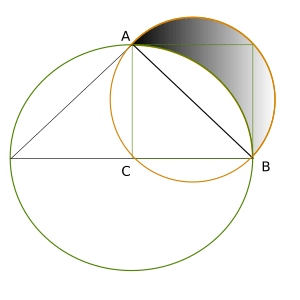Hippocrates of Chios facts for kids
Hippocrates of Chios (born around 470 BC, died around 410 BC) was an ancient Greek mathematician. He was also a geometer (someone who studies shapes) and an astronomer (someone who studies stars and planets).
He was born on the island of Chios. He started his career as a merchant. After some bad luck, like being robbed, he moved to Athens. There, he became a very important mathematician.
On Chios, Hippocrates might have learned from Oenopides, another mathematician. His work also showed some influence from the Pythagoreans. They were a group of thinkers known for their math ideas. Hippocrates was seen as a "fellow traveler" of their philosophy. He was known for using "proof by contradiction" in math. This is where you assume something is true, show it leads to a false result, and so prove it must be false.
Contents
Hippocrates' Math Discoveries
Hippocrates made a huge step in mathematics. He wrote the first organized geometry textbook. It was called Elements (which means "basic building blocks"). This book laid out basic theorems and ideas.
Because of his book, mathematicians everywhere could build on common ideas. This helped mathematics grow much faster.
Squaring the Circle
Only a small part of Hippocrates' Elements still exists today. This part talks about calculating the area of shapes called Hippocratic lunes. These are crescent-shaped figures.
This work was part of a bigger goal: to square the circle. This means trying to draw a square that has the exact same area as a given circle. Hippocrates thought if he could find the area of these crescent parts, he could find the area of the whole circle.
However, much later, in 1882, a mathematician named Ferdinand von Lindemann proved this was impossible. This is because the number pi (π) is a "transcendental number." This means it cannot be found by simple math operations like adding, subtracting, multiplying, or dividing whole numbers. Pi is the ratio of a circle's circumference to its diameter. It's also used to find a circle's area.
Laying the Foundation for Geometry
After Hippocrates, many other mathematicians wrote their own Elements books. They improved the ideas and logic. Hippocrates' pioneering work set the stage for Euclid's Elements. Euclid's book, written around 325 BC, became the standard geometry textbook for hundreds of years.
Hippocrates is also thought to be the first to use letters for points and shapes in math problems. For example, calling a triangle "triangle ABC" where A, B, and C are its corners.
Other Math Contributions
Hippocrates made two other important math contributions. He found a way to approach the problem of "duplication of the cube." This was another one of the three big math problems in ancient times. It meant trying to build a cube that had twice the volume of another cube.
He also invented a technique called "reduction." This means changing a specific math problem into a more general one. The general problem is often easier to solve. Once you solve the general problem, you automatically have the answer to the original, specific problem.
Hippocrates' Astronomy Ideas
In astronomy, Hippocrates tried to explain things like comets and the Milky Way. His ideas are not fully clear today. He likely thought both were optical illusions. He believed they were caused by light from the Sun or stars bending through moisture in the air.
He also thought that light rays came from our eyes, not from the object we were looking at. This makes his ideas seem very different from what we know today.
See also
 In Spanish: Hipócrates de Quíos para niños
In Spanish: Hipócrates de Quíos para niños


